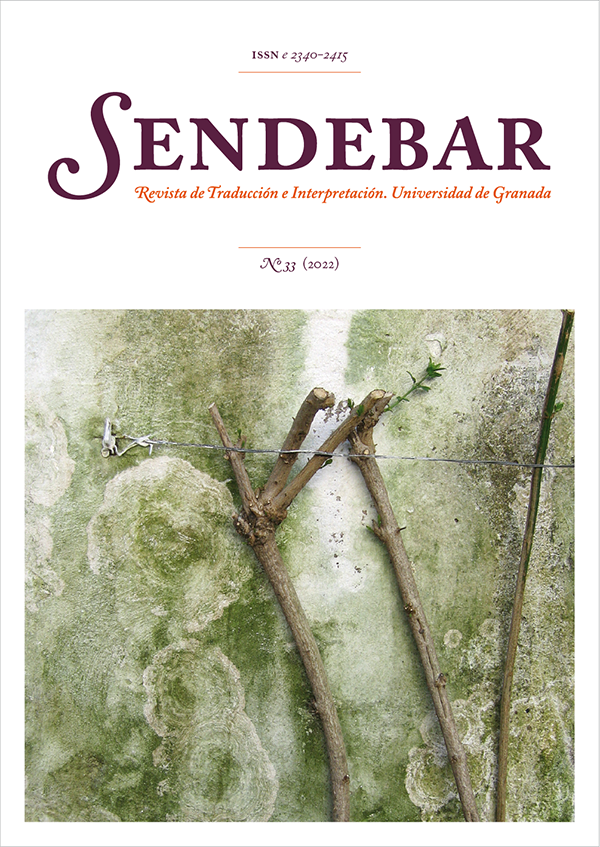Un marcador conversacional alemán y su traducción: posición y funciones de also en el diálogo ficticio
DOI:
https://doi.org/10.30827/sendebar.v33.23939Palabras clave:
marcadores conversacionales, partículas discursivas, oralidad ficticia, oralidad concepcional, construcción textual, polifuncionalidadResumen
Este trabajo analiza el uso de also en los diálogos de la novela Kleiner Mann – was nun?, de Hans Fallada, y su traducción al español. Mediante la aplicación de criterios estructurales y funcionales, se explica el modo en que esta partícula aparece representada en la obra y cómo su empleo ayuda a generar la ilusión de autenticidad que define la oralidad ficticia, pues su habitual posición periférica y sus funciones —vinculadas a la interactividad, el mantenimiento de la coherencia discursiva y la estructuración de la conversación— contrastan con sus usos prototípicos en la escritura. Por otra parte, se muestra cómo la elección de un equivalente de traducción en un momento concreto del diálogo se puede explicar en gran medida en consideración de las distintas maneras en que also contribuye a la construcción del discurso.
Descargas
Citas
Alm, M. (2015). Also als finale Partikel im Deutschen. En H. Vinckel (Ed.), Das Nachfeld im Deutschen (pp. 319-341). Berlin y Boston: de Gruyter.
Auer, P. y Günthner, S. (2005). Die Entstehung von Diskursmarkern im Deutschen. En T. Leuschner y T. Mortelmans (Eds.), Grammatikalisierung im Deutschen (pp. 335-362). De Gruyter.
Blühdorn, H., Foolen, A. y Loureda, Ó. (2017). Diskursmarker: Begriffsgeschichte – Theorie – Beschreibung. En H. Blühdorn et al. (Eds.), Diskursmarker im Deutschen. Reflexionen und Analysen (pp. 7-47). Verlag für Sprachforschung.
Breindl, E. et al. 2014. Handbuch der deutschen Konnektoren 2. De Gruyter.
Briz, A. y García-Ramón, A. (2021). La conversación coloquial como prototipo de lo dialogal. En Ó. Loureda y A. Schrott (Eds.), Manual de lingüística del hablar (pp. 261-285). De Gruyter. https://doi.org/10.1515/9783110335224-014
Brumme, J. (2008). Traducir la oralidad teatral. En J. Brumme et al. (Eds.), La oralidad fingida (pp. 21-64). Iberoamericana y Vervuert.
Brumme, J. (2012). Traducir la voz ficticia. De Gruyter.
Deppermann, A. y Helmer, H. (2013). Zur Grammatik des Verstehens im Gespräch. Zeitschrift für Sprachwissenschaft, 32, 1-39. https://doi.org/10.1515/zfs-2013-0001.
Dittmar, N. (2010). Zum Verhältnis von Form und (kommunikativer) Funktion in der mündlichen Rede am Beispiel des Konnektors also. En N. Dittmar y N. Bahlo (Eds.), Beschreibungen für gesprochenes Deutsch auf dem Prüfstand (pp. 99-135). Peter Lang.
Dittmar, N. (2012). Costruire il parlato: macro- e micro-sintassi. En E. Lombardi et al. (Eds.), Grammatica e pragmática (pp. 87-118). Il Calamo.
Duden. (2009). Die Grammatik. Dudenverlag.
Fallada, H. (1932/1994). Kleiner Mann – was nun? Aufbau.
Fallada, H. (2012). Pequeño hombre, ¿y ahora qué? Trad. Rosa Blanco. Maeva.
Fernández-Villanueva, M. (2007). Uses of also in oral semi-informal German. Catalan Journal of Linguistics, 6, 95-115. https://doi.org/10.5565/rev/catjl.126
Fiehler, R. et al. (2004). Eigenschaften gesprochener Sprache. Gunter Narr.
Freunek, S. (2007). Literarische Mündlichkeit und Übersetzung. Frank & Timme.
Fuentes, C. (2009). Diccionario de conectores y operadores del español. Arco Libros.
Goetsch, P. (1985). Fingierte Mündlichkeit in der Erzählkunst entwickelter Schriftkulturen. Poetica, 17, 202-218.
González, A. (2015). Un análisis funcional y descriptivo de los marcadores pragmáticos y su traducción como herramienta en la construcción del diálogo ficticio. Frank & Timme.
González, A. y Arias, B. (2017). Marcadors conversacionals en la traducció literaria alemany-català: also i na a Jeder stirbt für sich allein. Zeitschrift für Katalanistik, 30, 245-267.
Gülich, E. (1970). Makrosyntax der Gliederungssignale im gesprochenen Französisch. Fink.
Helbig, G. y Buscha, J. 2001. Deutsche Grammatik. Langenscheidt.
Koch, P. y Oesterreicher, W. (1985). Sprache der Nähe - Sprache der Distanz. Romanisches Jahrbuch, 36, 15-43. https://doi.org/10.1515/9783110244922.15
Koch, P. y Oesterreicher, W. (1990/2011). Gesprochene Sprache in der Romania. De Gruyter.
Konerding, K. P. (2004). Semantische Variation, Diskurspragmatik, historische Entwicklung und Grammatikalisierung. En I. Pohl y K. P. Konerding (Eds.), Stabilität und Flexibilität in der Semantik (pp. 198-237). Peter Lang.
López Serena, A. (2021). El hablar y lo oral. En Ó. Loureda y A. Schrott (Eds.), Manual de lingüística del hablar (pp. 243-260). De Gruyter. https://doi.org/10.1515/9783110335224-013
López Serena, A. y Borreguero, M. (2010). Los marcadores del discurso y la variación lengua hablada vs. lengua escrita. En Ó. Loureda y E. Acín (Eds.), Los estudios sobe marcadores del discurso en español, hoy (pp. 415-495). Arco Libros.
Loureda, Ó. y Pons, L. (2015). Partículas discursivas, gramaticalización y debilitamiento semántico. En E. Winter et al. (Eds.), Diskurstraditionelles und Einzelsprachliches im Sprachwandel (pp. 317-348). Gunter Narr.
Martín Zorraquino, Mª A. y Portolés, J. (1999). Los marcadores del discurso. En I. Bosque y V. Demonte (Eds.), Gramática descriptiva de la lengua española, v. 3 (pp. 4051-4213). Espasa.
Métrich, R. y Faucher, E. (2009). Wörterbuch deutscher Partikeln. De Gruyter.
Narbona, A. (2000). Sintaxis coloquial. En M. Alvar (Ed.), Introducción a la lingüística española (pp. 463- 478). Ariel.
Nicklaus, M. y Rocco, G. 2018. Fingierte Mündlichkeit und Übersetzen. Lebende Sprachen, 63, 393-429. https://doi.org/10.1515/les-2018-0023
Pasch, R. et al. 2003. Handbuch der deutschen Konnektoren 1. De Gruyter.
Ravetto, M. y Ballestracci, S. 2019. Sprachliche Indikatoren von Poetizität: das Beispiel von Konnektoren. En M. Dobstadt y M. Foschi (Eds.), Poetizität interdisziplinär (pp. 155-177). Villa Vigoni.
Robles, F. 2019. Són realment conversacionals els diàlegs teatrals? Aproximació estructural informativa. En F. Robles y P. Bertomeu (Eds.), La construcción del discurso en español y catalán (pp. 101-118). Helmut Buske.
Robles, F. 2022. Unidades procedimentales y construcción del diálogo ficticio. Círculo de Lingüística Aplicada a la Comunicación, 91, 187-203. http://dx.doi.org/10.5209/CLAC.78444
Sacks, H., Schegloff, E. y Jefferson, G. (1974). A simplest systematics for the organization of turn-taking for conversation. Language, 50, 696-735. https://doi.org/10.2307/412243
Schwitalla, J. (2012). Gesprochenes Deutsch. Erich Schmidt.
Thißen, J. (2013). Kleine Wörter – große Probleme. Germanistische Mitteilungen, 39, 3-13. https://doi.org/10.33675/GM/2013/1/2
Weinrich, H. (1993). Textgrammatik der deutschen Sprache. Duden.
Willkop, E.-M. (1988). Gliederungspartikeln im Dialog. Iudicium.
Wirf, M. (2008). La ilusión de proximidad. Jurek Becker en alemán y en español. En J. Brumme y H. Resinger (Eds.), La oralidad fingida (pp. 145-168). Iberoamericana y Vervuert.
Zifonun, G. et al. 1997. Grammatik der deutschen Sprache. De Gruyter.
Descargas
Publicado
Cómo citar
Número
Sección
Licencia
Terminos de Licencia Sendebar.

















